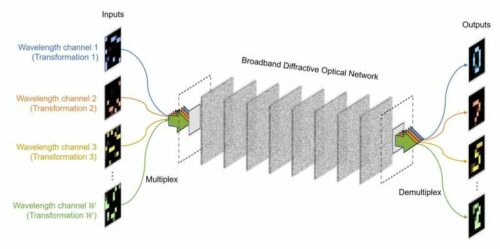Researchers have developed a wavelength-multiplexed diffractive optical processor that enables parallel computation of over 100 linear transformations.

Adapting photonics in processing technology could positively impact the speed and computation power of a system. It can enable parallel processing with low latency as well. A single optical processor can execute many distinct computational tasks simultaneously, such as the parallel computing of many different transformations, which could be valuable for numerous applications, including the acceleration of machine learning-based inference.
Researchers at the University of California, Los Angeles (UCLA) have developed a wavelength-multiplexed diffractive optical processor that enables the simultaneous computation of hundreds of different complex-valued linear transformations through different wavelength channels.
This optical processor consists of structured diffractive surfaces, made of passive transmissive materials. In this optical processor, a pre-determined group of discrete wavelengths encodes the input and output information. Each wavelength is dedicated to a unique target function or complex-valued linear transformation. Following the deep learning-based design phase, this processor can be fabricated using 3D printing or photolithography and then assembled to physically form an optical processor, which can simultaneously perform a large group of target transformations between its input and output.
These target transformations can be specified for distinct functions. These transforms can also be dedicated to computing different convolutional filter operations or fully connected layers in a neural network. By virtue of this unique wavelength multiplexed design, all these linear transforms or desired functions are executed simultaneously at the speed of light, where each desired function is assigned to a unique wavelength, allowing the broadband optical processor to compute with extreme throughput and parallelism.
This processor design does not require any wavelength-selective elements such as spectral or color filters, and is compatible with a wide range of materials with different dispersion properties. The UCLA researchers believe that this platform and the underlying concepts can be used to develop high-performance optical processors that operate at different parts of the electromagnetic spectrum, including the visible and infrared wavelengths.
Reference : Jingxi Li et al, Massively parallel universal linear transformations using a wavelength-multiplexed diffractive optical network, Advanced Photonics (2023). DOI: 10.1117/1.AP.5.1.016003





